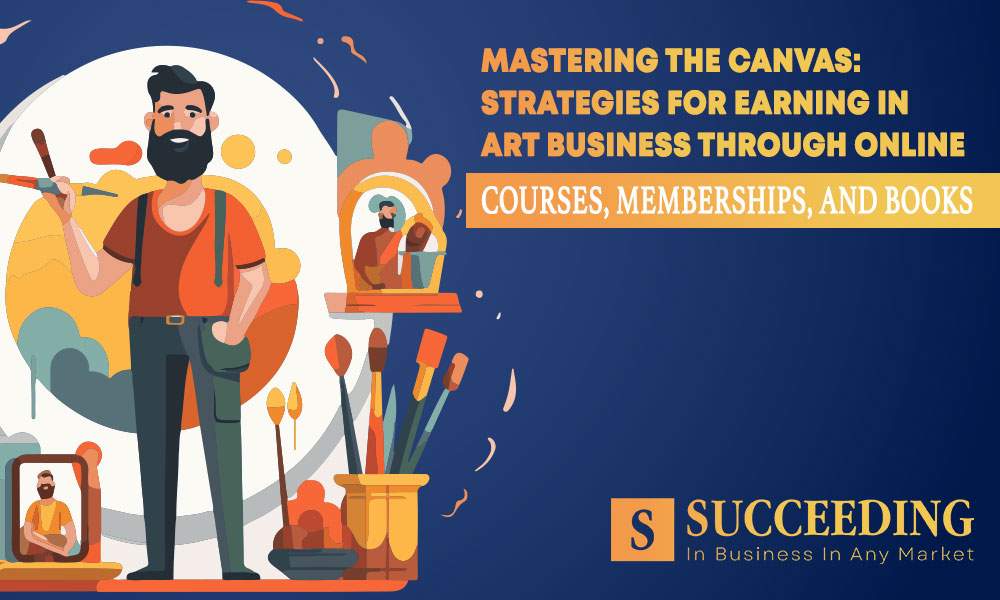Post Date: May 26, 2024

Mastering the Canvas: Strategies for Earning in Art Business through Online Courses, Memberships and Books
The art business is undergoing a profound transformation, and artists are increasingly diversifying their revenue streams to navigate the evolving landscape. In this guide, we delve into three powerful earning strategies—online courses, memberships, and books and explore how artists can master these avenues to not only sustain their artistic endeavors but also thrive financially.
The traditional model of selling art is expanding, and artists are embracing innovative strategies to monetize their skills beyond the canvas. “Strategies for Earning in Art Business” encapsulates the essence of this evolution, focusing on online courses, memberships, and books as key pillars of financial success for artists.
Online Courses as a Revenue Stream
Defining the Role of Online Courses:
Online courses have emerged as a dynamic revenue stream in the art business, offering artists a platform to share their expertise globally. These courses can range from technical tutorials to insights into the creative process, providing valuable content that resonates with a diverse audience.
Leveraging Digital Platforms:
The digital era has democratized education, enabling artists to reach students worldwide. Whether through platforms like Udemy, Skillshare, or proprietary websites, artists can transcend geographical barriers and establish themselves as educators on a global scale.
Building Communities through Memberships
Conceptualizing Memberships:
Memberships represent a paradigm shift in how artists engage with their audience. By offering exclusive content, early access, or special experiences, artists can cultivate a community of dedicated supporters who contribute to a sustainable income stream.
Benefits of Memberships:
The benefits extend beyond financial gains; memberships foster a sense of belonging and loyalty. Members feel a deeper connection to the artist’s journey, creating a symbiotic relationship that goes beyond a simple transaction.
Authoring and Selling Art Books
The Significance of Art Books:
Art books serve as a timeless medium for artists to share their vision, techniques, and narratives. From monographs that showcase a body of work to instructional books or even coffee table books, artists can reach a broader audience and leave a lasting legacy.
Navigating Publishing:
The process of bringing an art book to life involves crucial decisions, including whether to self-publish or pursue traditional publishing. Each path has its advantages and challenges, requiring artists to carefully consider their goals and audience.
Synergies Between Earning Strategies
Holistic Earning Approaches:
The true potential of financial success lies in the synergy between earning strategies. Successful artists seamlessly integrate online courses, memberships, and books, creating a diversified portfolio that not only maximizes revenue but also enhances their brand and impact.
Diversification for Financial Stability:
The art market is inherently unpredictable. Diversification across multiple earning streams provides artists with financial stability, reducing dependence on a single source of income and offering resilience in the face of market fluctuations.
Marketing and Promoting Earning Strategies
Strategic Promotion:
Effectively marketing these strategies is key to success. Social media, email marketing, and collaborations play pivotal roles in reaching a broader audience. Artists should adopt a cohesive brand image that spans across different earning channels, creating a unified and recognizable presence.
Connecting with the Audience:
Building a personal connection with the audience is paramount. By sharing behind-the-scenes glimpses, engaging in conversations, and responding to feedback, artists can foster a community that is not only supportive but also invested in their success.
Navigating Challenges and Overcoming Obstacles
Common Challenges:
Implementing these strategies is not without its challenges. Artists may face issues such as market saturation, competition, or technological barriers. Acknowledging these challenges and proactively addressing them is crucial for long-term success.
Success Stories of Overcoming Challenges:
Real-world anecdotes of artists who successfully navigated challenges provide inspiration and practical insights. From adapting to changing market trends to overcoming initial resistance, these stories offer valuable lessons for aspiring artists.
Scaling Earning Strategies for Long-Term Success
Adapting to Change:
The scalability potential of each strategy allows artists to adapt to changing circumstances. Regularly reassessing and evolving these strategies ensures that artists stay relevant and continue to meet the evolving needs of their audience.
Creating a Roadmap for Scalability:
A roadmap for scaling is essential. Artists should set clear goals, regularly assess performance metrics, and be open to experimentation. This proactive approach ensures that scalability becomes an integral part of their long-term success.

Conclusion
In the dynamic realm of the art business, mastering the canvas involves not only creating captivating artworks but also strategically navigating the avenues of online courses, memberships, and books. Diversifying income streams is not merely a financial strategy but a means to cultivate a thriving and resilient artistic career.
FAQs (Frequently Asked Questions)
Q: How can artists effectively promote their online courses, memberships, and books?
A: Strategic promotion involves utilizing social media, email marketing, collaborations, and maintaining a cohesive brand image. Engaging with the audience through behind-the-scenes content and responding to feedback also enhances promotional efforts.
Q: What challenges might artists face when offering memberships, and how can they overcome them?
A: Common challenges include establishing value for members and retaining their interest. Artists can overcome these challenges by offering exclusive content, unique experiences, and maintaining consistent communication to foster a sense of community.
Q: What factors should artists consider when deciding between self-publishing and traditional publishing for their art books?
A: Artists should consider their goals, audience, and level of creative control. Self-publishing provides autonomy but requires more involvement, while traditional publishing offers wider distribution but may involve relinquishing some creative control.
Q: How can artists maintain a balance between creating art and managing the administrative aspects of online courses, memberships, and book projects?
A: Artists can streamline administrative tasks through automation tools and strategic planning. Delegating certain responsibilities or seeking support from professionals in areas like marketing or logistics can also alleviate the administrative burden.
Q: Is it advisable for emerging artists to immediately dive into multiple earning strategies, or should they focus on one initially?
A: Starting with a focused approach is advisable for emerging artists. They can gradually explore additional strategies as they establish themselves and understand their audience. Diversification should be a strategic progression based on their growth and goals.





